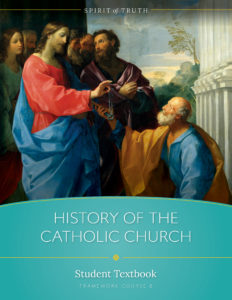Overview
Students will explore the history of the Catholic Church beginning with her origins in the beginning of time and institution during the earthly life of Christ, to the period of rapid growth in the apostolic era and the centuries that followed, through the rise and fall of nations, kingdoms, and Empires over the course of two millennia, to the present day.
- Spirit of Truth, High School Course B Teacher’s Guide
- Spirit of Truth, High School Course B Student Textbook
- Spirit of Truth, High School Course B Student Workbook
- Glossary
- Glossary of Historical Figures
- Final Exam
- Final Exam Answer Key
- Final Exam Study Guide
- Final Exam Essay Questions Form A
- Final Exam Essay Questions Form B
- Final Exam Essay Questions Form C
Units
In Unit 3, we will examine Jesus’ public ministry more closely, looking at how His saving mission brought light into the world. First, we will see how Jesus’ ministry began at His Baptism, so as to serve as an example for all of us to follow. Then we will see how at the height of His ministry He proclaimed the Kingdom of God so that we can respond to His call and become members of His Kingdom. Finally, we will explore how He instituted the Eucharist as a memorial of His Death and Resurrection, so as to make present the Paschal Mystery for us in the Eucharistic Liturgy celebrated every day throughout the entire world. As the Roman Empire crumbled and fell, its territory fell into the Dark Ages, so-called because of the lack of historical sources for us to look back on this time clearly today, but also because of the regression of society and culture, and the suffering experienced by the people due to the lack of infrastructure, defense against violent invaders, political machinations, and lack of available education. It was in this darkness that the Church took up the Cross as a source of light shining on the Truth. The second millennium of Christianity began with division. The next centuries saw war, plague, and much suffering, yet also brought forth a revival in learning with the dawn of the university, new religious orders dedicated to spreading the Gospel, and the beauty and culture of the Renaissance. Beginning in the sixteenth century, large numbers of Christians began to protest certain abuses in the Church. Many of the reasons for protest were justified, but the way these Protestant reformers went about reform led to division and schism in the Church. While there have been certain rifts in the Church since the time of the Apostles, the split between East and West and the Reformation were unprecedented. The division of Christians is a tragedy that is caused by sin. The Catechism calls schisms and separations “ruptures that wound the unity of Christ’s Body” (817). The Church responded to the errors of the Protestant Reformation by calling the Council of Trent, which led to a period of great reform in the Church called the Counter Reformation. Inspired by the spirit of renewal coming out of the Counter Reformation, explorers and missionaries began to spread Catholic Christianity to the Americas and the Far East. These missionaries brought Christ to the native peoples of these lands and, in many cases, endured great hardship and even martyrdom. But the Gospel message took hold in these places, leading to many conversions. The 18th and 19th centuries were a time of great upheaval. Revolutions in thought, in politics, in economies and production, and in warfare led to unprecedented and rapid cultural change. Enlightenment thinkers questioned everything, especially the nature of truth itself, concluding that the only truth is our own truth, and even that truth does not exist at all. A perfect society, then, would be one built only by the use of human reason, rather than the eternal truths of God which, they falsely concluded, did not exist at all. These new ideas led to revolution across Europe that rewrote the structure of society and geographic and political boundaries. The Church pressed on, however, in her mission to make disciples of all nations, and many saints rose to the occasion to defend the Truth of Christ. After the end of WWI, it may have seemed inconceivable that there could be a greater threat to human civilization on the horizon. And yet, as the twentieth century progressed, these greater threats emerged. In the post-World War II world, the popes worked for reconciliation and peace while warning against the great threats the world still faced. The Council Fathers worked to determine new ways to pastorally present the unchanging truths of the Faith to the modern world. Vatican II led to new efforts in biblical study, evangelization, reforms in the liturgy, and a renewed effort at ecumenism and interfaith dialogue.


